If you love beef and udon noodles, Beef Udon (Niku Udon ) is the dish for you. The sweetness of the beef topping goes well with the plain udon noodle soup. It is a simple but filling noodle soup with plenty of beef.
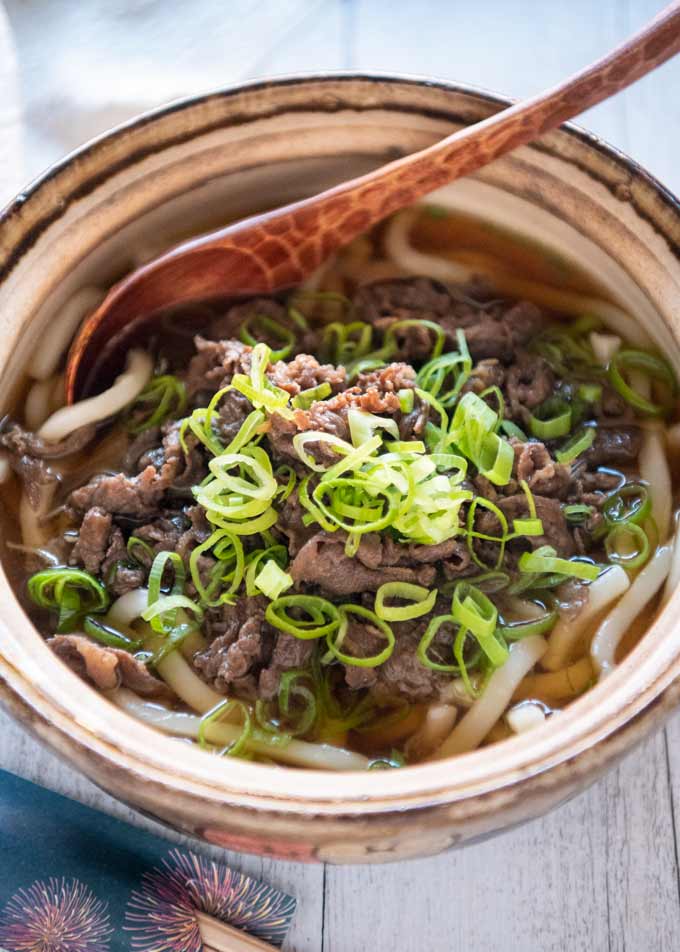
The Japanese name of this dish, Niku Udon (肉うどん), does not translate to Beef Udon because the word ‘niku’ (肉) means meat, not beef. Niku Udon can be made with pork or chicken meat but sliced beef is by far the most popular meat for this dish.
In my post Japanese Beef and Rice (Beef Takikomi Gohan), I mentioned that this dish was also called ‘niku gohan’. And it is a very simple rice dish. Well, today’s dish is almost like the noodle version of it. The ingredients to cook the beef are quite similar to Beef Takikomi Gohan.
What’s in Beef Udon (Niku Udon)
Beef Udon is made of udon noodles, a dashi-based broth and flavoured beef toppings.
Udon Noodles:
Udon noodles can be either home-made, a packet of dried udon noodles from a shop or a packet of pre-cooked fresh noodles from a shop (photo below from left in this order ).
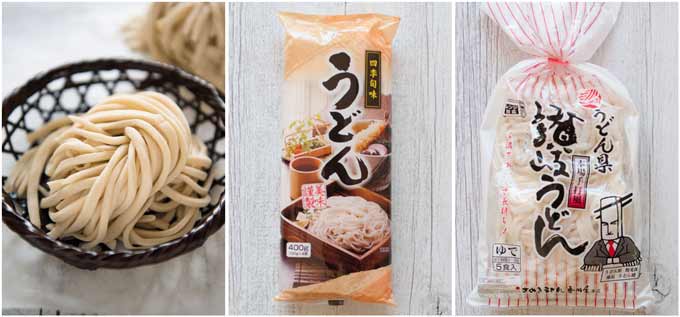
If you are using Home-made Udon Noodles or dried udon noodles, you need to boil them and get ready to use. If you are using pre-cooked fresh udon noodles, you just need to warm them up by blanching them in boiling water.
Broth:
The broth for Beef Udon is a typical noodle broth made of the following ingredients (for 1 serving):
- 300ml / 10oz dashi stock
- 1 tablespoon light soy sauce
- 1 teaspoon mirin
- A pinch of salt
If you compare the proportion of the ingredients with the broth made for Tempura Udon, you will notice that the ingredients above are slightly different. Since the topping has a soy flavour, I made a slightly lighter broth for Beef Udon than the standard noodle broth.
Use of light soy sauce makes the colour of the broth lighter. But if you don’t have it, you can use normal soy sauce.
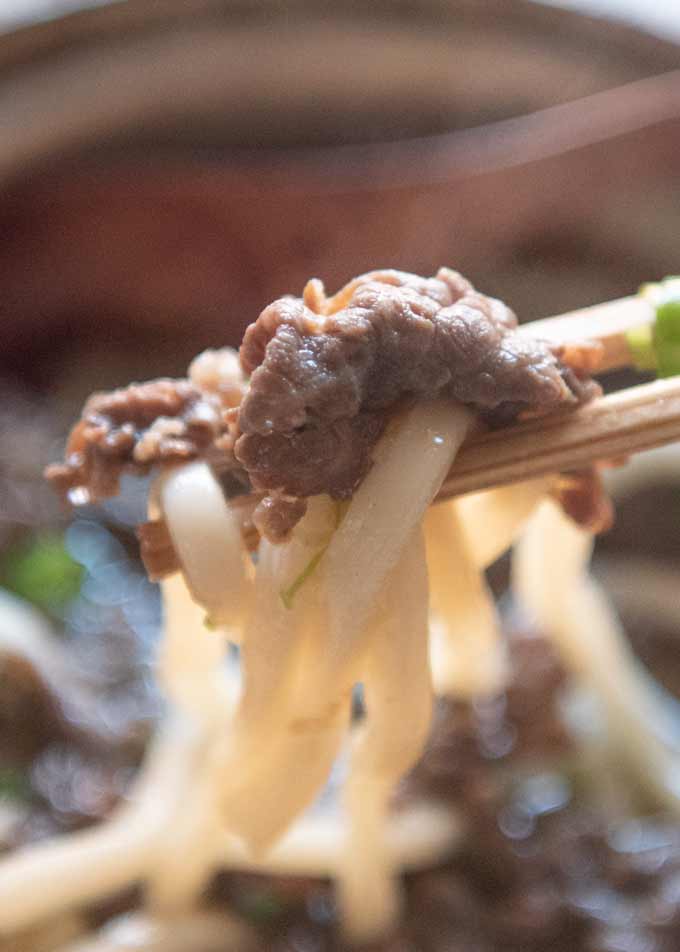
Toppings:
- Thinly sliced beef
- Julienned ginger
- Dashi stock
- Soy sauce
- Cooking sake
- Mirin
- Sugar
- Chopped shallots/scallions to scatter at the end (optional but strongly recommended to add a colour to the dish)
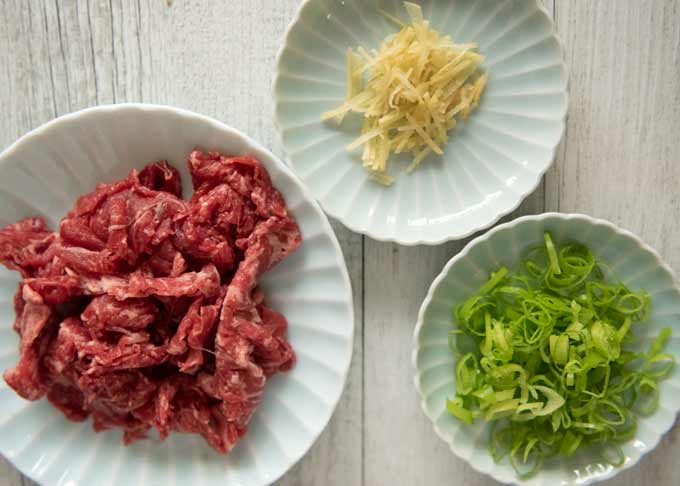
I used the frozen thinly sliced beef that I bought from the Asian grocery store. You can instead slice a block of beef by hand. Rib eye, sirloin or top side steak would be good.
Some recipes do not use dashi stock and just add water instead. But I think that the beef toppings taste better with dashi stock added.
How to Make Beef Udon (Niku Udon)
It does not take a very long time to cook Niku Udon.
- Cook the beef with other topping ingredients until only a small amount of liquid is left over (takes about 5 minutes).
- Boil udon noodles (takes about 10 minutes) or warm up if using cooked udon.
- Mix all the ingredients for the broth and bring it to a boil (takes 5 minutes).
- Transfer the noodles and the broth to a serving bowl, then place the beef on top. Scatter the shallots/scallion over the beef.
The way I cook the beef is very simple too. You don’t even sauté the beef. Just bring all the topping ingredients, except beef, to a boil then add ginger and beef.

Since all these three Beef Udon components need to be hot when putting them together, utilising the cooktop burners becomes quite important.
I use three cooktop burners, i.e. one burner to boil and warm up udon noodles, one to make the broth and one to cook the beef toppings.
If you only have two burners, I would suggest that you allocate one for udon and the other for the broth and the toppings. At the time of serving, you should have the broth on the cooktop. As soon as the broth is brought to a boil, put the toppings on the burner.
If you have only one burner, you can use a microwave to heat up the noodles and bring the broth to a boil on the cooktop. As soon as the broth is heated up, put the toppings on the cooktop to heat up.
Beef Udon (Niku Udon) is a very simple udon noodle recipe but it’s so satisfying with a generous amount of flavoursome beef slices as toppings. And it takes only 20 minutes to make.
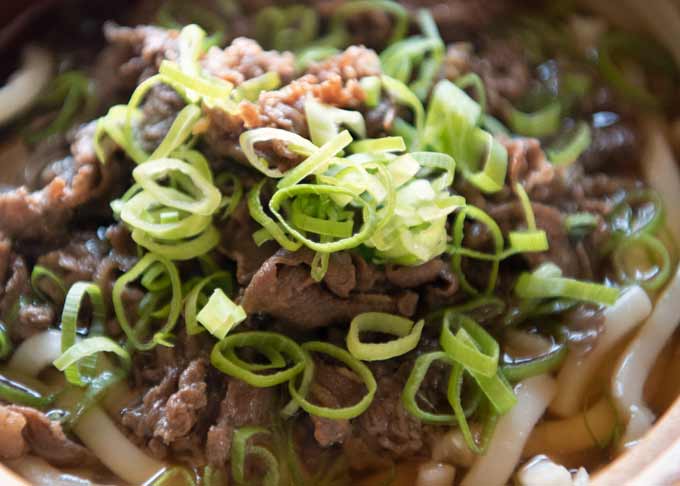
Yumiko![]()
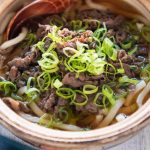
If you love beef and udon noddles, Beef Udon (Niku Udon) is the dish for you. The sweetness of the beef topping goes well with the plain udon noodle soup. It is a simple but filling noodle soup with plenty of sliced beef.
Don't forget to see the section 'MEAL IDEAS' below the recipe card! It gives you a list of dishes that I have already posted and this recipe that can make up a complete meal. I hope it is of help to you.
- 1 serving udon noodles (note 1)
- 2 tbsp shallots/scallions finely chopped
- 130g / 4.6oz thinly sliced beef (note 2)
- 1 tbsp ginger finely julienned
- 1 tbsp dashi stock
- 1 tbsp soy sauce
- 1 tsp cooking sake
- 1 tbsp mirin
- 1 tsp sugar
- 300ml / 10oz dashi stock
- 1 tbsp light soy sauce (or normal soy sauce)
- 2 tsp mirin
- A pinch of salt
-
Boil udon noodles per the instructions to al-dente. Rinse them in running cold water until the noddles cool down completely, then drain (note 3).
-
Add all the Broth ingredients in a saucepan and bring it to a boil.
-
Put all the Beef Toppings ingredients, except beef, into a skillet and bring it to a boil over medium heat.
-
Add beef to the skillet, untangling each slice of the beef. Cook until a small amount of liquid is left at the bottom of the skillet - see the photo in the section, HOW TO MAKE BEEF UDON (NIKU UDON) in the post.
-
Turn the heat off and leave until required.
-
Bring water in a saucepan to a boil and blanch the udon noodles to warm them up. Drain well and transfer to a serving bowl.
-
Pour the hot broth over the noodles. Untangle the noodles in the broth if required.
-
Transfer the beef (note 4) on top of the noodles and scatter the chopped shallots/scallions over the beef. Serve immediately.
1. Any types of udon noddles are OK. If you have time, make them from scratch per my recipe Home-made Udon Noodles.
Alternatively, buy a packet of dried udon noodles or precooked fresh udon noodles. They are available at supermarkets and Japanese/Asian grocery stores.
2. I bought a packet of frozen sliced beef from the Asian grocery store. It came in a very large slice so I halved it.
Otherwise, get a rib eye, sirloin or top side steak and very thinly slice it.
3. If you are using precooked noodles, no need to boil.
4. If the beef gets cold, reheat it. Discard the small amount of liquid left in the skillet.
5. It is important that the noodles, the broth and the toppings are all hot when putting together. See the section, HOW TO MAKE BEEF UDON in the post, which talks about how I utilise 3 cooktop burners to keep them hot.
6. Nutrition per serving. I assumed half of the flavouring sauce for the beef is discarded. It also assumed the entire broth is consumed but it's unlikely. You can cut back a significant amount of sodium by not drinking the broth too much.
serving67g calories: 557kcal fat: 25g (38%) saturated fat: 9.7g (49%) trans fat: 0.0g polyunsaturated fat: 1.5g monounsaturated fat: 10g cholesterol: 89mg (30%) sodium: 2009mg (84%) potassium: 1081mg (31%) carbohydrates: 39g (13%) dietary fibre: 1.7g (7%) sugar: 11g protein: 38g vitamin a: 2% vitamin c: 4.3% calcium: 3.6% iron: 23%
Meal Ideas
A typical Japanese meal consists of a main dish, a couple of side dishes, a soup and rice. I try to come up with a combination of dishes with a variety of flavours, colours, textures and make-ahead dishes.
Beef Udon hardly has any vegetables in it so I decided to have side dishes with good amount of vegetables.
If you think that the amount of beef in the Beef Udon is sufficient, you can replace Pumpkin Soboro-an with Kabocha no Nitsuke.
For Side dish 2, if you are not fond of wasabi mayonnaise, you can serve a different vegetable salad.
- Main: Beef Udon – today’s recipe, make ahead toppings
- Side dish 1: Steamed Pumpkin with Beef Mince Sauce (Pumpkin Soboro-an) – or Simmered Pumpkin (Kabocha no Nitsuke), make ahead
- Side dish 2: Root Vegetable Salad with Wasabi Mayonnaise – or other salad with plenty of vegetables
- Side dish 3: Simple Pickled Celery – make ahead, or other pickled dish
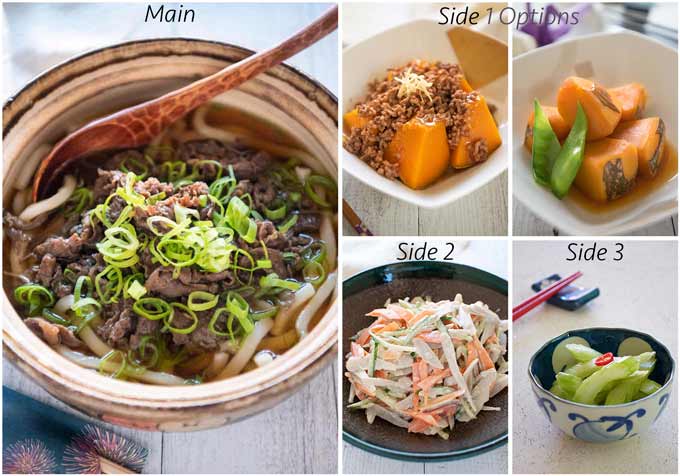
Hi Yumiko
Thank you so much for this recipe! It was delicious, the broth just right. I used porterhouse steak very thinly sliced, it was perfectly seasoned, I followed your recipe exactly. We all loved it
Hi Jacqui, thanks for the great feedback! I’m glad everyone enjoyed it.
This was so delicious thank you for sharing this recipe! My family and I enjoyed it (: I used your dashi recipe as well and liked it a lot!
Hi Monet, thank you! I am glad you enjoyed it.
I have found my new addiction! This is delicious, tastes exactly like when I buy niku udon from a restaurant! I used instant dashi powder as I ran out of kombu, and also purchased “hotpot-style” pre-sliced beef from my local Asian grocer. It was perfect!
For anyone trying this recipe, the only tricky thing to beware of is making sure you don’t over-cook the thinly sliced beef on the stove – if you serve it in hot broth, it will continue cooking in the bowl! I cooked my beef slices until they were rare on the stove, then assembled my bowl & poured the hot soup over the top – leaving me with tender, medium-rare beef slices! <3 fantastic job, I will make this regularly!
Hi Georgia, that’s great and thank you very much for a little tip for not overcooking beef.
Hi Yumiko! Hmmm, why is this dish so addicting? No need to answer because this is more of a compliment than a true question – haha. I enjoy Japanese food & had been wanting to try some Japanese recipes, but I struggled sourcing all of the ingredients, particularly the dashi. I’ve seen something called “Hondashi” made by Ajinomoto at my local Asian market. I was tempted to purchase it, but decided not to do it when I saw there was MSG in it.
Fortunately for me, I was able to find awase dashi powder with no MSG on Amazon – yay! Once I have all the ingredients, the only trouble I had with this recipe was the measurement on the udon noodles as it only specifies “one serving”. After browsing around, I assumed 90 grams = one serving of udon noodles.
I love how everything turned out!! My husband and toddler(s) love it, too!! The only thing I’m not happy about is the beef that turned out a bit tough. Perhaps I overcooked it? If you have any suggestion, I’d love to hear it!
Thank you for sharing such a wonderful recipe, Yumiko! I will surely try your other recipes!
Hi Lufi, sorry for not specifying the quantity of ‘1 serving’. If you are buying a fresh udon noodles in a packet, a think pack is usually one serving. Dried noodles should indicate on the pack about servings the entire pack or a bunch serves. I will add this to the note serction. I appreciate your bringing up to my attention.
Re beef, it is possible that the beef was too thick. Did you slice yourself or did you buy sliced beef? The beef needs to be very thin, about 2mm / 1/16″ thick like Skiyaki beef slices. When you make such thin slices of meat, it is best to partially freeze a block of meat, then slice. Try to slice perpendicular to the direction of the tissue. Each piece of beef does not have to as large as the beef slices that I used either. They can be thinly sliced off cuts.
Hi Yumiko
When we eat out for Japanese food we always have Niku Udon noodle soup or Sukiyaki beef noodle soup. Your recipe for Niku Udon is the absolute best recipe ever. I bought a bottle dashi from a Japanese grocery store in Melbourne. This made it easy, very quick and enormously successful with the toppings you suggested. It is so delicious. Thank you SO much.
Jo
Hi Jo, I am glad you liked Niku Udon. There are so many handy seasoning bottles you can buy at Japanese grocery stores, can’t you? And they are time savers!
Hi Yumiko
Mostly a good recipe and quite simple. Like the idea of using three burners!
One suggestion I want to pass on is for you to eliminate the “pinch of salt.” It is completely nonsensical and just wrong to add salt when you are already using Soy sauce which is liquid salt. In fact, it is nearly impossible to justify ever adding salt to any Japanese recipes since so many of the flavorings have salt in them. Please consider this for the health of your readers.
Hi Jay, thank for a note. Sometimes, you add a salt when you want a bit more saltiness without making the broth darker by adding more soy sauce. To get the same saltiness of a pinch of salt, you need to add about 1 teaspoon of soy sauce. So your statement of ‘not justifiable’ is actually not accurate. That is assuming that the presentation of the dish is important to you.
Individual has a different palate and some people are sensitive to the saltiness, some not. It is up to individual to adjust the salitness.
There’s no indication for how much water you should use for the broth…
Hi Sean, dashi stock is liquid, which consists of water and stock ingredients such as konbu and bonito flakes. If you click the link for dashi stock, you will get to the post for how to make dashi stock. You will need 300ml of dashi stock made this way.
But if you are using store-bought dashi powder instead of making dashi stock at home, use 300ml of water with required amount of powder. The sachet of the powder should tell you the amount of powder you need.
Hi Yumiko! This is the perfect dish for winter, it was so easy to make and it turned out so delicious too 😀 My family really enjoyed it. Thanks for the yummy recipe!
Hi Sam, thanks for leaving a great comment. I’m glad you all enjoyed it!
Hi Yumiko, we’ve just made the Niku Udon Noodle Soup and it was perfect and delicious. Our local Asian supermarket had run out of Dashi sachet so we had to buy the Dashi seasoning. The instructions for the seasoning were in Japanese and we therefore had to guess how much seasoning to use. We probably put in too much but we diluted it with some beef stock which worked well for our first time making this. Could you please give us an indication of how much seasoning we should use in the future. I have been looking for a recipe for this soup for a couple of years and your recipe is lovely and very easy. It’s definitely going to be added to my favourites list. Thank you so much Yumiko. Jo (In lockdown in Melbourne)
Hi Jo, I am glad to hear you enjoyed Beef Udon. Re dashi seasoning, the quantity to use might depend on the brand but I will certainly include the information in future. Stay safe and hang in there, Jo.
Hi Yumiko, this looks and sounds great, perfect for cold wintry weather, can’t wait to try it!
Hi Anne, it is quite easy to make . Please let me know what you think.